Mention Peru and most people immediately think Inca. The iconic image of Machu Picchu‘s mystical ruins has invaded our collective psyche to such a degree that we tend to associate the country solely with the ancient Inca culture. Unquestionably, the Incas were a force to be reckoned with but they were by no means the only indigenous people in Peru; they were simply the last and best known race because Spanish conquistadors documented their existence after arriving.
Peru was inhabited 14,000 years ago by hunters and gatherers who gradually became sedentary and began to cultivate crops and herd llamas and alpacas. By 3000 B.C., the Sacred City of Caral-Supe (sometimes referred to as the Norte Chico civilization) was being built on a dry desert terrace just north of present-day Lima, making it the oldest known civilization in the Americas, one of only six sites where civilization originated in the ancient world. Though this 5,000-year old archeological site features six monumental pyramidal structures that show clear evidence of ceremonial functions and a powerful religious ideology, it is barely known outside the region, perhaps because the culture was pre-ceramic and showed no evidence of art, leading some scientists to dispute that it was a true civilization. After the decline of the Caral-Supe civilization around 1800 B.C., a series of cities rose up in the northern Andean highlands and along the northern coast of Peru, all of which had rich artistic traditions that left no doubt about their status as true Pre-Inca civilizations.
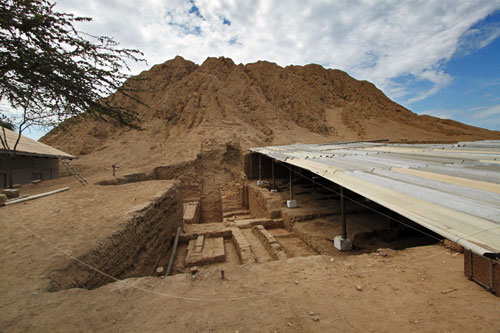
Though Machu Picchu was my prime focus in Peru I also wanted to learn more about these lesser-known cultures, beginning with the Moche civilization that ruled the northern coast from around 1 AD to 700 AD. In Chiclayo, I arranged for a day tour of the Lord of Sipan Tombs, said to contain riches rivaling those of King Tutankhamen’s in Egypt. My tour bus ground to a halt, kicking up billows of mousy brown dust that instantly coated my boots and glasses as I stepped down onto drought-cracked earth. Other than the occasional bush or tree that had gained a foothold in this sere environment, the only relief in the dull plain before me was a pair of unremarkable low mounds with flanks deeply scoured by erosion.
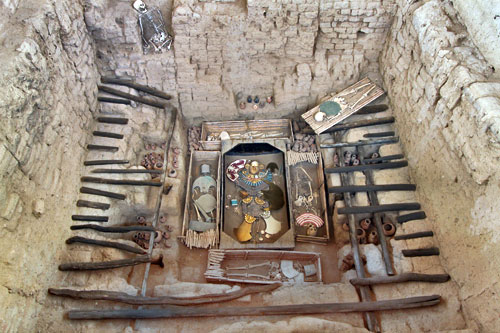
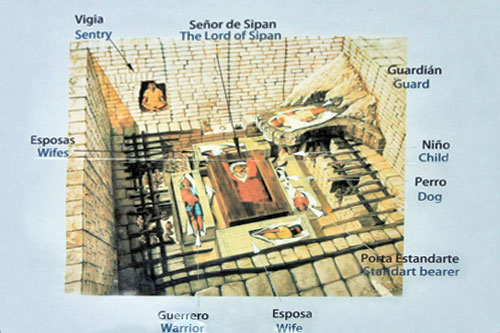
Atop of one of these mounds, sheltered from the swirling dust by tin roofs that protect the excavations, I peered into an exposed crypt that had held the remains of the Lord of Sipan, a 40-year old high-ranking warrior-priest. Today the articles contained within it are only reproductions; the real artifacts have been removed to the nearby Museo Tumbes Reales Del Señor de Sipan (Museum of the Royal Tombs of the Lord of Sipan), where they are safe from looters. The painstakingly recreated tomb is well-done, providing an excellent overview of the full regalia worn by the deceased, including pectoral shields made of shell, bone and stone; blankets adorned with gilded copper platelets; two finely worked metal necklaces; headdresses; feather ornaments; and three sets of turquoise earrings. In his right hand he grips a scepter shaped like an inverted pyramid, while Spondylus shells, used as currency by the Moche; silver and gold rattles; knives; and golden death-masks lay scattered around the tomb.
That so many of the real artifacts have survived is something of a minor miracle. For years looters had been digging around the mounds, hoping to unearth articles of value that could be sold on the black market. At midnight on February 25th, 1987, the police chief of Chiclayo phoned Dr. Walter Alva, Director of Peru’s Bruning Museum, insisting that he immediately come down to the station and examine a sack full of what he believed were stolen artifacts taken from the mounds near the village of Sipan. Expecting to find a few pieces of pottery, Alva peered into the sack; to his surprise it contained a human mask made of hammered gold, with eyes of silver and pupils made of rare cobalt blue stones. Raiding of the site had started several weeks earlier. The thief, 36 year-old Ernil Bernal, had led a small group of looters to the pyramids hoping to find something of value. They tunneled into the pyramid, eventually breaking into a chamber where they found a fortune in gold, silver and precious stones.
News of the find traveled fast and several days later the police raided Bernal’s house. They found the death mask and several other smaller items, but most of the treasure was already on its way to illegal private collections and museums around the world. Some of these pieces were hidden in chair cushions that were sent to the United States in large crates of furniture. Customs agents in the U.S. found the illicit items and cooperated with the government of Peru to track the black market criminals, returning the pieces to Peru upon completion of their investigation. To this day, items from the Lord of Sipan tomb continue to show up on the black market. In August 2006, an artifact that had been looted from the tomb in 1988 was recovered in a raid on a London law firm; the golden headdress with a feline face surrounded by eight curving tentacles was estimated to be worth more than £1 million.
To date, researchers have excavated three major tombs at Sipan, and numerous other minor burials have been found at the site, including a second high priest known as the “Old Lord of Sipan” and a male figure sitting in an upright position whose feet had been cut off, ostensibly to prevent him from leaving his post. The excavated areas constitute just a small fraction of the buried pyramids, indicating there is much more wealth to be uncovered, however the government of Peru lacks funds for excavations and must rely on donations of money and personnel from foreign governments, thus work proceeds slowly. Thankfully, the site is today secure and the people of the adjacent village of Sipan have taken it upon themselves to safeguard the burial ground of their ancestors.
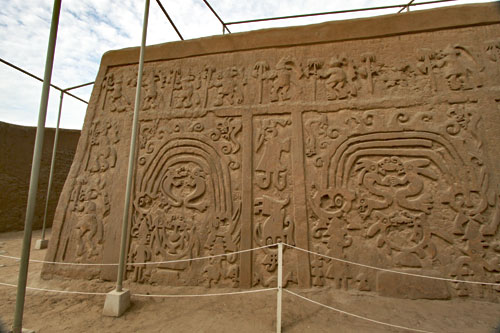
Several days later I headed four hours further south to the city of Trujillo to visit the great city of Chan Chan, built by Chimú descendants of the Moche culture around 900 AD. The walls of this largest of the ruined Andean civilization cities enclosed an area of about eight square miles, within which were ten or more huge rectangular palace compounds, each of which had its own public buildings, water supply and cemeteries. The majority of the residents in each ciudadela were artisans; some experts estimate that about 12,000 artisans lived and worked in Chan Chan alone during the late Chimú period.
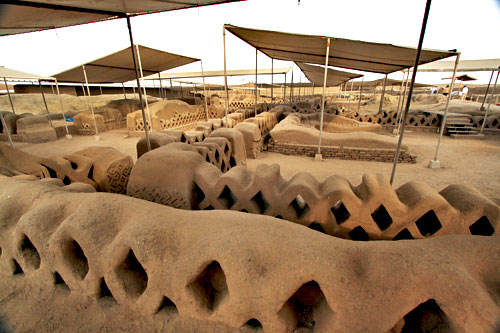
Strangely, for an advanced society that had developed excellent farming techniques and an advanced complex of irrigation canals, and which had mastered ceramics, textile-making, and metallurgy, the construction techniques employed at Chan Chan seemed surprisingly primitive. The walls were constructed of adobe brick that was covered with a smooth surface into which intricate designs were carved. Being located directly on the coast, these mud walls are continually subjected to heavy rains, flooding, and strong winds. Though funds have been raised to cover a small portion of the ruins, most stand exposed to the elements and as a result, the world’s largest adobe city melts away a bit more with each rainstorm. Sad to say, unless drastic measures are taken to save this site, there will soon be little evidence of a civilization that extended the entire length of modern Peru, from Ecuador in the north to Chile in the south, in the 13th and 14th centuries.
Despite their advanced culture, in the end, the Chimú also succumbed. Between 1465 and 1470 they were conquered by the fierce Incas and absorbed into their civilization, as had most other indigenous cultures in the Andes and the coastal plains by that time. Little wonder that the Incas are synonymous with Peru.
Where to Stay in Chiclayo:
When my bus arrived in Chiclayo, I asked a taxi driver to take me to Muchik Hostel. First he tried to drop me off at a restaurant named Muchik, then took me to Mochick’s Hotel. Assuming it was the correct place, I let him drive off, only to learn that the hostel was five or six blocks away. I later understood that there are many enterprises in and around Chiclayo that use some version of the work Muchik, which was the language spoken by the ancient Moche (or Mochica) civilization that once inhabited this area of the coast. I was dead tired, so I negotiated with the front desk and they offered me a rate of $36 per night for a private, ensuite single, which was a significant discount from their regular rates. I decided to splurge and was delighted with my lovely air-conditioned room, which was outfitted with double bed, flat screen TV, in-room wi-fi and upscale bathroom. The hotel is brand new and is ideally located just three blocks from the main plaza of Chiclayo. Contact them through their website at the link provided above, email at [email protected], or phone 95 8468436 (cell) or 74 206620 (telephone). Country code is +51.
Tours of The Lord of Sipan Tombs and Museum in Chiclayo:
I booked a day tour to the tombs and Museo Tumbas Reales del Senor de Sipan (Museum of the Royal Tombs of the Lord of Sipan) at a free-standing city tourist booth, located just a block from my hotel. On the particular day I wanted to go, there was no English-speaking guide available and my time was limited, so I opted to do the tour in Spanish, which was much lower priced than one with an English-speaking guide. Though the tour was adequate, the guide spoke rapid-fire Spanish and I repeatedly had to ask her to slow down a bit. Additionally, she rushed us through the Lord of Sipan Museum, where all the actual artifacts are on display, and we never made it to the second or third floor. The tour also included a stop at the Brüning Museum in Lambayeque, where the Lord of Sipan artifacts had been housed prior to the opening of the new museum. Now that all the Lord of Sipan riches have been relocated there is not much to see at the Brüning. The entire time, I felt like our guide was rushing so she could be done with the tour. If I were to do it again, I’d either hire a taxi for the day or take the local buses to the sites so that I could visit them at leisure. The actual excavated tombs are located in the Lambayeque Valley, next to the village of Sipan, just 35 km. (21 miles) east of Chiclayo. The Museo Tumbas Reales del Senor de Sipan is located 11 Km. (6.6 miles) north of Chiclayo in Lambayeque at Avenues Juan Pablo Vizcardo y Guzman. It is open seven days per week from 9 a.m. to 5 p.m. and allows 300 people per hour to enter. The entrance fee is 15 Peruvian Soles, or about $4.50 USD. Their phone is 74 283978, country code +51.
Where to stay in Trujillo:
From Chiclayo, I took a comfortable air-conditioned double-decker bus to Trujillo for 14 Peruvian Soles (about $2.75 USD). Ask for the front seat on the top level and you’ll have a wrap-around view of the scenery during the three-hour ride. In Trujillo, I stayed at Residencial Munai Wasi, a private home that had a guest wing for tourists. I had a nice, private room with a bathroom right outside my bedroom door for 45 Soles ($17 USD), which included a light breakfast of rolls and coffee. The town’s magnificent Plaza Principal was just six blocks away. The hostel is located at 250 Avenida Colón. Phone 044 231462 or 044 9301983, country code +51.
Visiting the Moche and Chimú Ruins Around Trujillo:
I booked a day tour with one of the many tour agencies located on the pedestrian mall that leads to the Plaza Principal. The tour visited the Moche site known as Huacas de Sol y Luna (Temples of the Sun and Moon), where spectacular colored paintings and carvings on behemoth walls are still visible more than 1,200 years after their creation; a museum dedicated to the Chan Chan culture and two separate Chan Chan ruins: a temple of the working class people and the Ex-Palacio Tschudi and Nik-An Murals. At the end of the day, the tour bus stopped at the cozy little beach town of Huanchaco, where we were able to stroll along the Malecon or out onto the Municipal Pier for about 45 minutes. Price for the tour was 30 Peruvian Soles (slightly more than $11 USD). There was a stop for lunch but it was not included in the price of the ticket. Highly recommended.

Wow, this ancient tomb in Peru looks so mystical to me. This place speaks a lot of its history and culture.
The
post is handsomely written. I have bookmarked you for keeping abreast with your
new posts.
gmat tutor in Delhi
http://www.aabhatutors.com
I like these informative blogs about Peru. As an europerean this culture is exciting, but also very new to me – in spite of being married to sweet peruvian wife. Looking forward to follow-ups!
Awesome post, I never know about this place and its history. Also fantastic pictures to add colors to it. thanks for sharing.
It does seem strange that a culture that lasted less than 200 years (Incas) gets all the press and notice – I guess that is the power of Cusco and Machu Picchu. I loved all the historic cultures
– Tiahuanaco, Chimu, Nazca etc though I didn’t manage to get to the North (sadly) because of time. It took longer to get around than I’d planned. Let’s hope that Peru is doing a better job of preserving their culture. Great article and photos.
Wonderful! We’ve visited all of those sites and more. We were surprised to discover there were many more cultures besides the Mochi and the Chimu, there were the Wari, Nasca, Paracas, Chincha and the Chavin cultures (+ several more). My passion has been ancient cultures, and Peru is definitely rich in ancient history, some even say has alien roots. My son and I have loved exploring Peru and find ourselves still here after arriving nearly 7 months ago. Still more to explore, I’m afraid. I am so glad you highlighted these wonderful sites. Great photos Barbara!
Hi ilainie: You are so welcome. I was so fascinated by the wealth of ancient cultures in Peru – wish I could have visited more sites. I even had to skip the Nazca lines because I ran out of time, but that just gives me an excuse to return. Interesting that you mention aliens. During my tour of Colca Canyon I rode next to a mother and daughter who live in the U.S. but originally came from Peru. They told me about all the mummies at the local museum in Arequipa that exhibit alien features. Another one had recently been found and put on display. Unfortunately, I had to leave early the next morning so never got a chance to see it, but it certainly is intriguing.
Yes, I read about that exhibit! I still hope to go. We saw the Moche Mummy near Trujillo affectionately referred to as The Lady of Cao, but she was definitely human. But the similarities between the Egyptian traditions were astounding.
We stopped at the The Paracas History Museum and had a very interesting conversation with the curator. He showed us several points on the non-human skulls that differed from the human skulls. I am still fascinated! I have a short video on my site if you are interested. http://www.raisingmiro.com/2012/02/06/elongated-skulls-of-paracas/There is so much to explore here in Peru! You have to find your way back here in the near future, for sure!
Wow! You brought history to life and gave me some vicarious travel too :=)) Thank you. Fascinating post.
Thanks Linda! I always wonder how people will react to the posts tat are loaded with history and facts.
Fantastic. I wonder why so little is known about them — I’d never heard of any of the ruins.
Lane, While I was in Ecuador I was very lucky to have met a woman from Lima in one of my dorms. She told me all about Chiclayo and Trujillo and insisted I must see them.Thank goodness I took her advice. There were only a few people at each site and each one is truly amazing.
Fantastic post, Barbara! I had heard of the “other” sites in Peru but not is such detail. Thanks!
information is great here for the tourists, i will be visiting this place again.